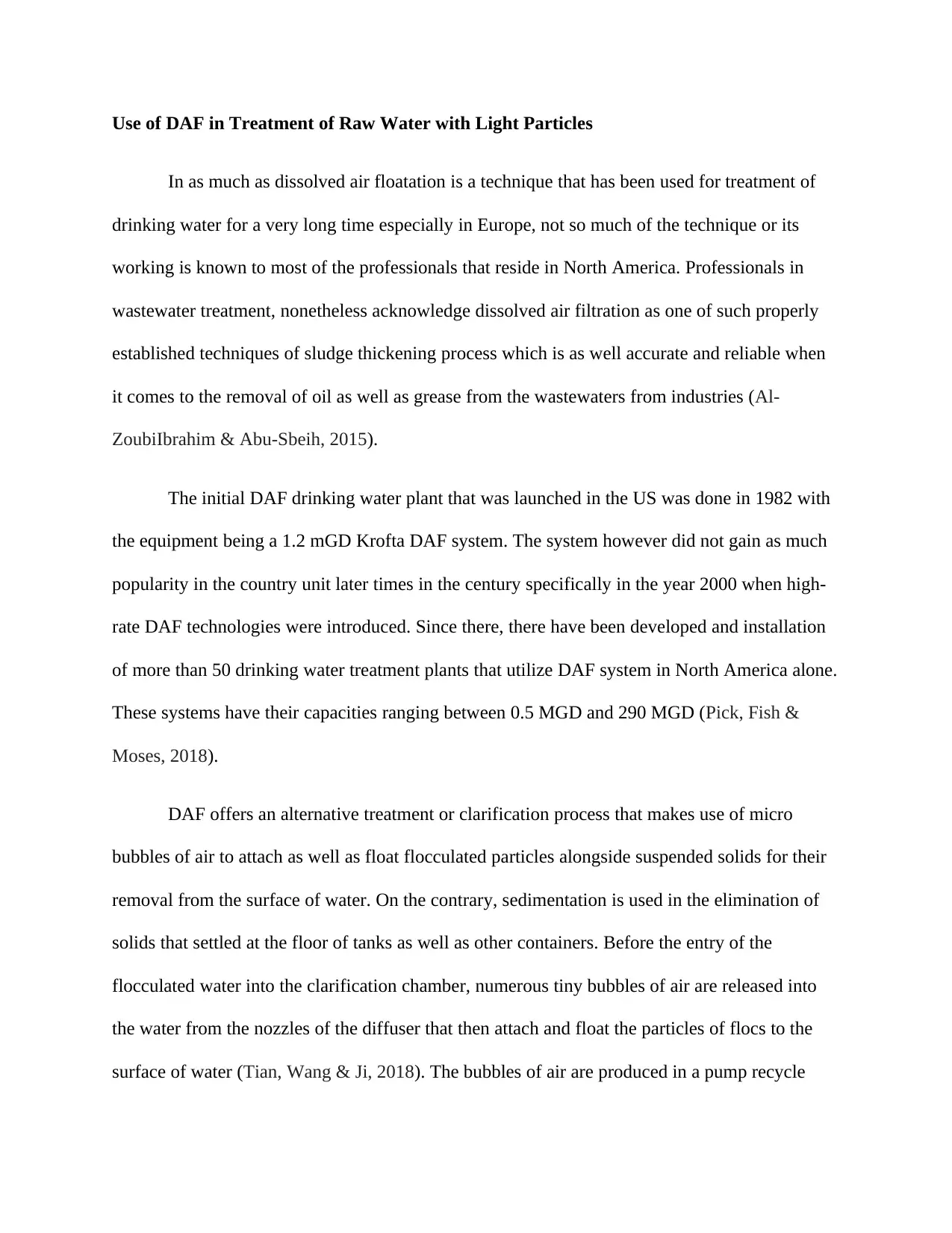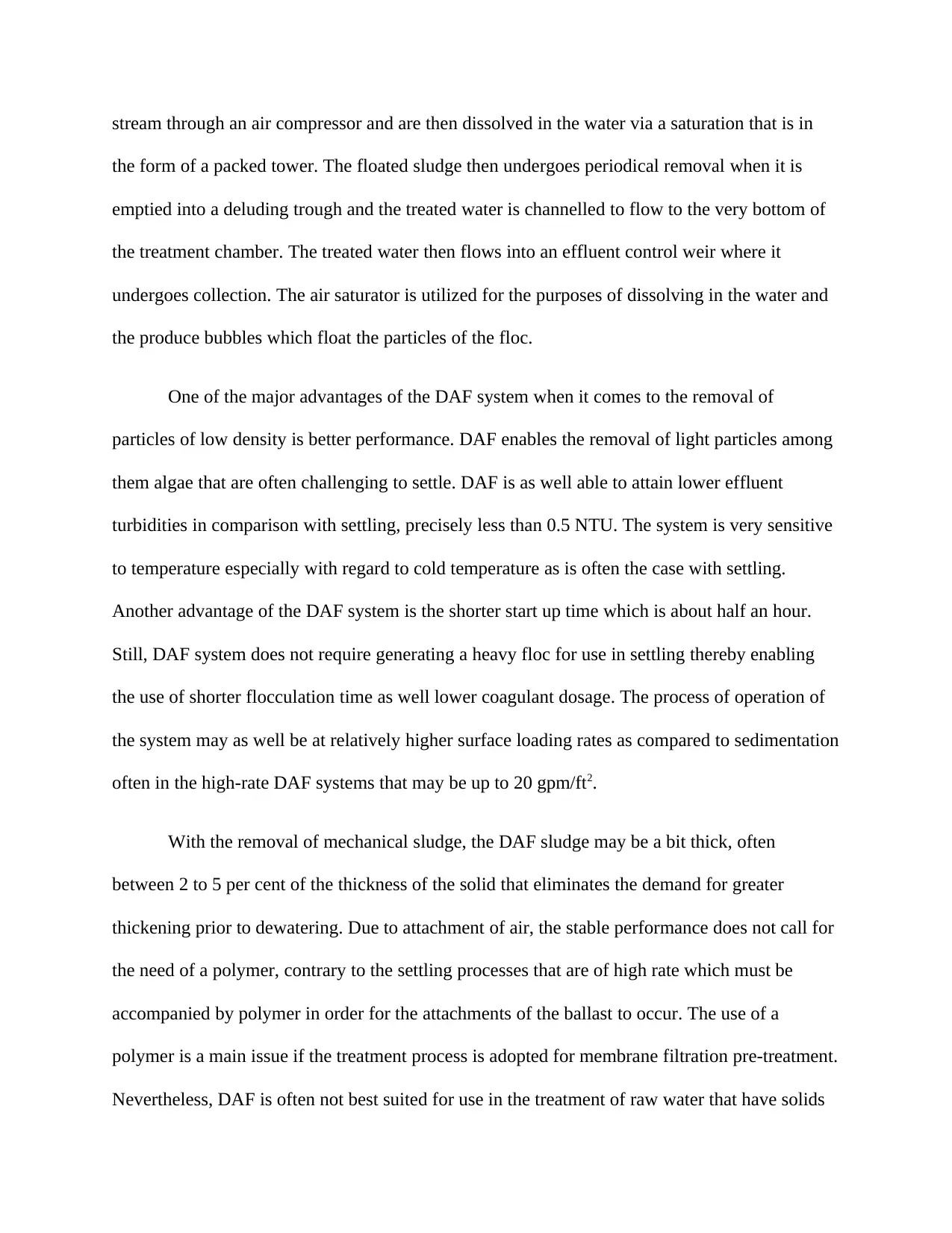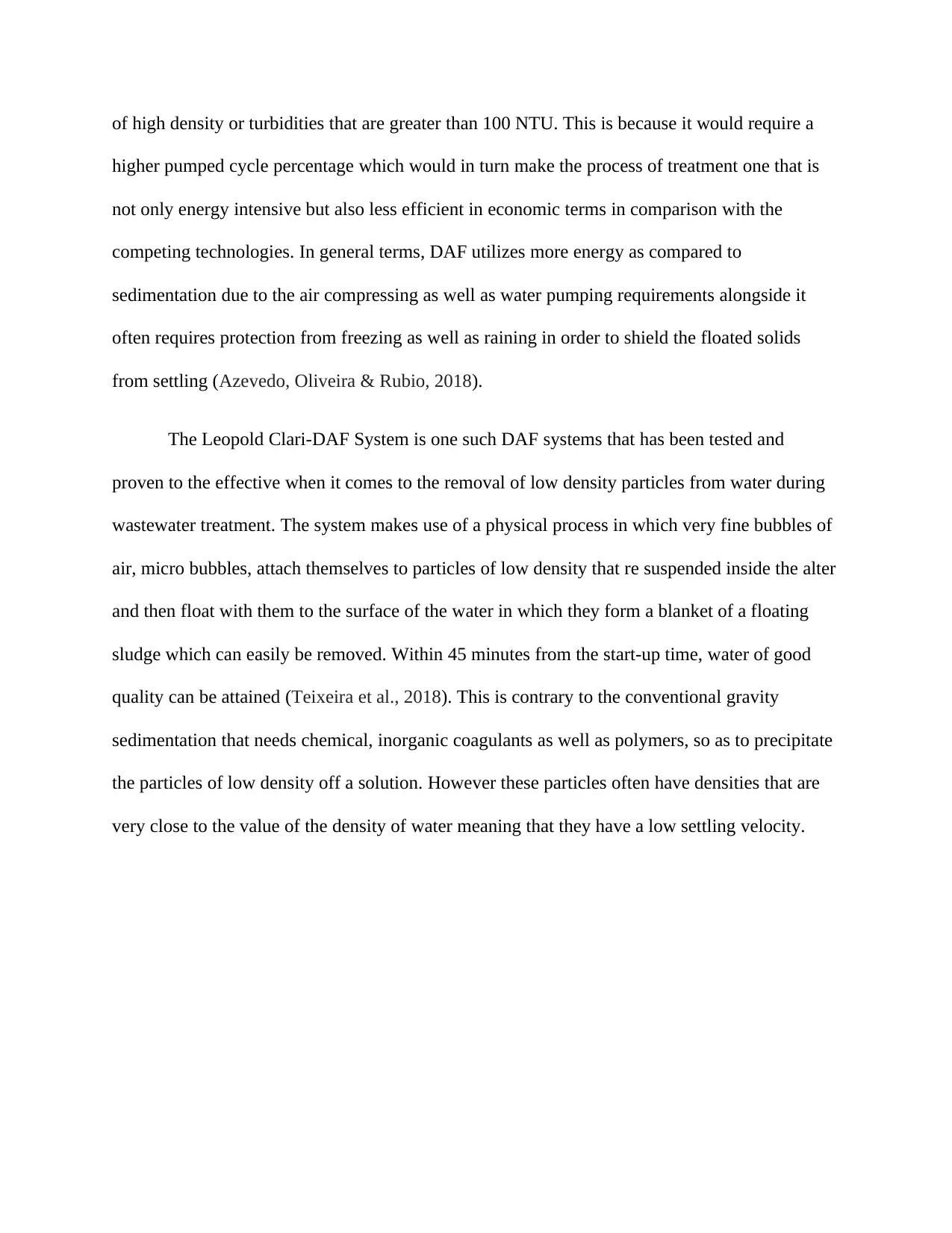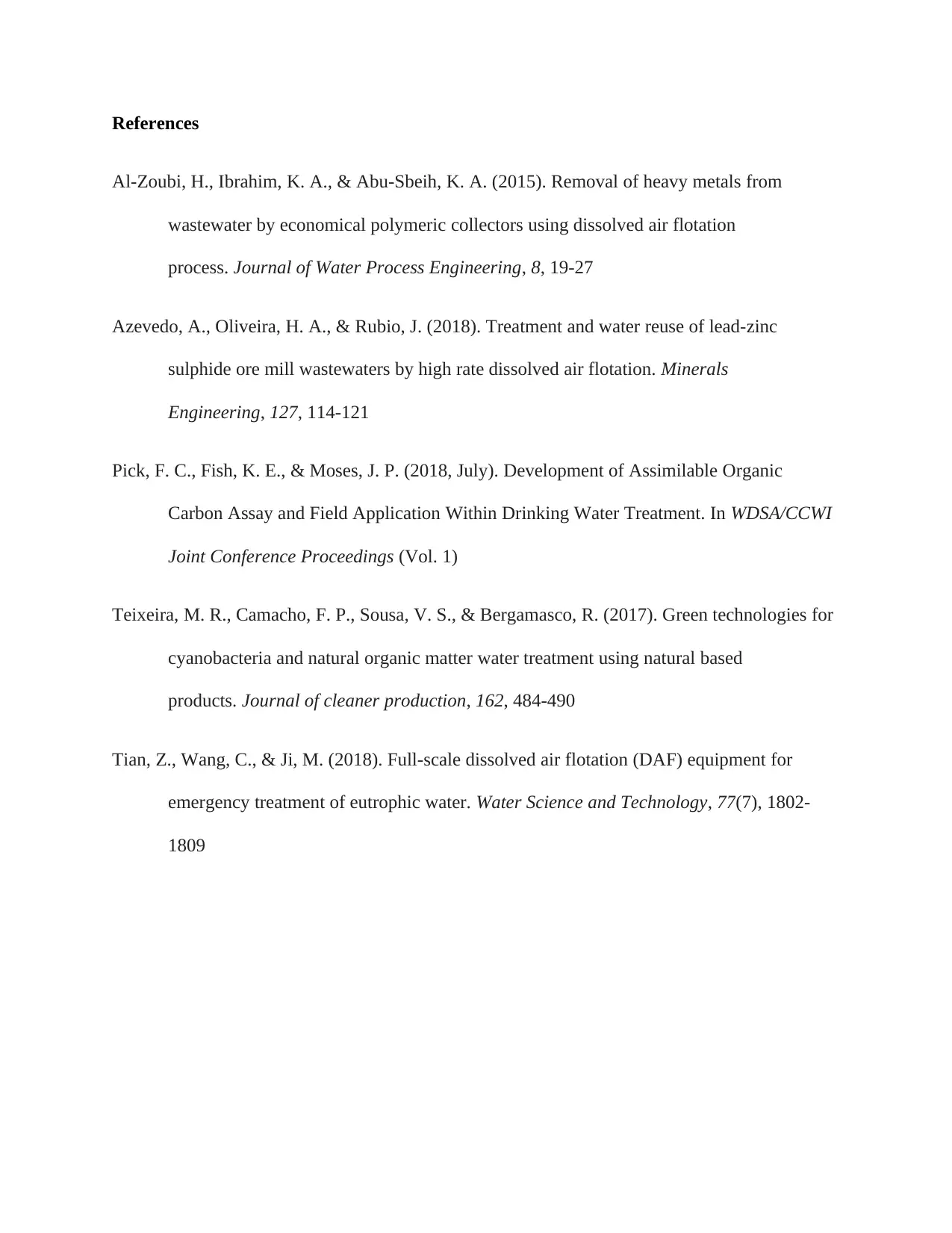Dissolved Air Flotation: Treating Raw Water with Light Particles
VerifiedAdded on 2023/06/04
|4
|1230
|114
Report
AI Summary
This report explores the application of Dissolved Air Flotation (DAF) in the treatment of raw water, particularly focusing on its effectiveness in removing light particles. DAF, a well-established technique in Europe, utilizes micro bubbles to attach to and float flocculated particles and suspended solids for removal. The report highlights the advantages of DAF, including its ability to remove light particles like algae, achieve lower effluent turbidities, and its insensitivity to cold temperatures. It also discusses the shorter start-up time and the ability to operate at higher surface loading rates. However, DAF is not ideally suited for raw water with high-density solids or high turbidities, and it generally consumes more energy than sedimentation. The report references the Leopold Clari-DAF System as an example of a DAF system proven effective in removing low-density particles. This document is available on Desklib, where students can find similar reports and study resources.

Use of DAF in Treatment of Raw Water with Light Particles
In as much as dissolved air floatation is a technique that has been used for treatment of
drinking water for a very long time especially in Europe, not so much of the technique or its
working is known to most of the professionals that reside in North America. Professionals in
wastewater treatment, nonetheless acknowledge dissolved air filtration as one of such properly
established techniques of sludge thickening process which is as well accurate and reliable when
it comes to the removal of oil as well as grease from the wastewaters from industries (Al-
ZoubiIbrahim & Abu-Sbeih, 2015).
The initial DAF drinking water plant that was launched in the US was done in 1982 with
the equipment being a 1.2 mGD Krofta DAF system. The system however did not gain as much
popularity in the country unit later times in the century specifically in the year 2000 when high-
rate DAF technologies were introduced. Since there, there have been developed and installation
of more than 50 drinking water treatment plants that utilize DAF system in North America alone.
These systems have their capacities ranging between 0.5 MGD and 290 MGD (Pick, Fish &
Moses, 2018).
DAF offers an alternative treatment or clarification process that makes use of micro
bubbles of air to attach as well as float flocculated particles alongside suspended solids for their
removal from the surface of water. On the contrary, sedimentation is used in the elimination of
solids that settled at the floor of tanks as well as other containers. Before the entry of the
flocculated water into the clarification chamber, numerous tiny bubbles of air are released into
the water from the nozzles of the diffuser that then attach and float the particles of flocs to the
surface of water (Tian, Wang & Ji, 2018). The bubbles of air are produced in a pump recycle
In as much as dissolved air floatation is a technique that has been used for treatment of
drinking water for a very long time especially in Europe, not so much of the technique or its
working is known to most of the professionals that reside in North America. Professionals in
wastewater treatment, nonetheless acknowledge dissolved air filtration as one of such properly
established techniques of sludge thickening process which is as well accurate and reliable when
it comes to the removal of oil as well as grease from the wastewaters from industries (Al-
ZoubiIbrahim & Abu-Sbeih, 2015).
The initial DAF drinking water plant that was launched in the US was done in 1982 with
the equipment being a 1.2 mGD Krofta DAF system. The system however did not gain as much
popularity in the country unit later times in the century specifically in the year 2000 when high-
rate DAF technologies were introduced. Since there, there have been developed and installation
of more than 50 drinking water treatment plants that utilize DAF system in North America alone.
These systems have their capacities ranging between 0.5 MGD and 290 MGD (Pick, Fish &
Moses, 2018).
DAF offers an alternative treatment or clarification process that makes use of micro
bubbles of air to attach as well as float flocculated particles alongside suspended solids for their
removal from the surface of water. On the contrary, sedimentation is used in the elimination of
solids that settled at the floor of tanks as well as other containers. Before the entry of the
flocculated water into the clarification chamber, numerous tiny bubbles of air are released into
the water from the nozzles of the diffuser that then attach and float the particles of flocs to the
surface of water (Tian, Wang & Ji, 2018). The bubbles of air are produced in a pump recycle
Paraphrase This Document
Need a fresh take? Get an instant paraphrase of this document with our AI Paraphraser

stream through an air compressor and are then dissolved in the water via a saturation that is in
the form of a packed tower. The floated sludge then undergoes periodical removal when it is
emptied into a deluding trough and the treated water is channelled to flow to the very bottom of
the treatment chamber. The treated water then flows into an effluent control weir where it
undergoes collection. The air saturator is utilized for the purposes of dissolving in the water and
the produce bubbles which float the particles of the floc.
One of the major advantages of the DAF system when it comes to the removal of
particles of low density is better performance. DAF enables the removal of light particles among
them algae that are often challenging to settle. DAF is as well able to attain lower effluent
turbidities in comparison with settling, precisely less than 0.5 NTU. The system is very sensitive
to temperature especially with regard to cold temperature as is often the case with settling.
Another advantage of the DAF system is the shorter start up time which is about half an hour.
Still, DAF system does not require generating a heavy floc for use in settling thereby enabling
the use of shorter flocculation time as well lower coagulant dosage. The process of operation of
the system may as well be at relatively higher surface loading rates as compared to sedimentation
often in the high-rate DAF systems that may be up to 20 gpm/ft2.
With the removal of mechanical sludge, the DAF sludge may be a bit thick, often
between 2 to 5 per cent of the thickness of the solid that eliminates the demand for greater
thickening prior to dewatering. Due to attachment of air, the stable performance does not call for
the need of a polymer, contrary to the settling processes that are of high rate which must be
accompanied by polymer in order for the attachments of the ballast to occur. The use of a
polymer is a main issue if the treatment process is adopted for membrane filtration pre-treatment.
Nevertheless, DAF is often not best suited for use in the treatment of raw water that have solids
the form of a packed tower. The floated sludge then undergoes periodical removal when it is
emptied into a deluding trough and the treated water is channelled to flow to the very bottom of
the treatment chamber. The treated water then flows into an effluent control weir where it
undergoes collection. The air saturator is utilized for the purposes of dissolving in the water and
the produce bubbles which float the particles of the floc.
One of the major advantages of the DAF system when it comes to the removal of
particles of low density is better performance. DAF enables the removal of light particles among
them algae that are often challenging to settle. DAF is as well able to attain lower effluent
turbidities in comparison with settling, precisely less than 0.5 NTU. The system is very sensitive
to temperature especially with regard to cold temperature as is often the case with settling.
Another advantage of the DAF system is the shorter start up time which is about half an hour.
Still, DAF system does not require generating a heavy floc for use in settling thereby enabling
the use of shorter flocculation time as well lower coagulant dosage. The process of operation of
the system may as well be at relatively higher surface loading rates as compared to sedimentation
often in the high-rate DAF systems that may be up to 20 gpm/ft2.
With the removal of mechanical sludge, the DAF sludge may be a bit thick, often
between 2 to 5 per cent of the thickness of the solid that eliminates the demand for greater
thickening prior to dewatering. Due to attachment of air, the stable performance does not call for
the need of a polymer, contrary to the settling processes that are of high rate which must be
accompanied by polymer in order for the attachments of the ballast to occur. The use of a
polymer is a main issue if the treatment process is adopted for membrane filtration pre-treatment.
Nevertheless, DAF is often not best suited for use in the treatment of raw water that have solids

of high density or turbidities that are greater than 100 NTU. This is because it would require a
higher pumped cycle percentage which would in turn make the process of treatment one that is
not only energy intensive but also less efficient in economic terms in comparison with the
competing technologies. In general terms, DAF utilizes more energy as compared to
sedimentation due to the air compressing as well as water pumping requirements alongside it
often requires protection from freezing as well as raining in order to shield the floated solids
from settling (Azevedo, Oliveira & Rubio, 2018).
The Leopold Clari-DAF System is one such DAF systems that has been tested and
proven to the effective when it comes to the removal of low density particles from water during
wastewater treatment. The system makes use of a physical process in which very fine bubbles of
air, micro bubbles, attach themselves to particles of low density that re suspended inside the alter
and then float with them to the surface of the water in which they form a blanket of a floating
sludge which can easily be removed. Within 45 minutes from the start-up time, water of good
quality can be attained (Teixeira et al., 2018). This is contrary to the conventional gravity
sedimentation that needs chemical, inorganic coagulants as well as polymers, so as to precipitate
the particles of low density off a solution. However these particles often have densities that are
very close to the value of the density of water meaning that they have a low settling velocity.
higher pumped cycle percentage which would in turn make the process of treatment one that is
not only energy intensive but also less efficient in economic terms in comparison with the
competing technologies. In general terms, DAF utilizes more energy as compared to
sedimentation due to the air compressing as well as water pumping requirements alongside it
often requires protection from freezing as well as raining in order to shield the floated solids
from settling (Azevedo, Oliveira & Rubio, 2018).
The Leopold Clari-DAF System is one such DAF systems that has been tested and
proven to the effective when it comes to the removal of low density particles from water during
wastewater treatment. The system makes use of a physical process in which very fine bubbles of
air, micro bubbles, attach themselves to particles of low density that re suspended inside the alter
and then float with them to the surface of the water in which they form a blanket of a floating
sludge which can easily be removed. Within 45 minutes from the start-up time, water of good
quality can be attained (Teixeira et al., 2018). This is contrary to the conventional gravity
sedimentation that needs chemical, inorganic coagulants as well as polymers, so as to precipitate
the particles of low density off a solution. However these particles often have densities that are
very close to the value of the density of water meaning that they have a low settling velocity.
⊘ This is a preview!⊘
Do you want full access?
Subscribe today to unlock all pages.

Trusted by 1+ million students worldwide

References
Al-Zoubi, H., Ibrahim, K. A., & Abu-Sbeih, K. A. (2015). Removal of heavy metals from
wastewater by economical polymeric collectors using dissolved air flotation
process. Journal of Water Process Engineering, 8, 19-27
Azevedo, A., Oliveira, H. A., & Rubio, J. (2018). Treatment and water reuse of lead-zinc
sulphide ore mill wastewaters by high rate dissolved air flotation. Minerals
Engineering, 127, 114-121
Pick, F. C., Fish, K. E., & Moses, J. P. (2018, July). Development of Assimilable Organic
Carbon Assay and Field Application Within Drinking Water Treatment. In WDSA/CCWI
Joint Conference Proceedings (Vol. 1)
Teixeira, M. R., Camacho, F. P., Sousa, V. S., & Bergamasco, R. (2017). Green technologies for
cyanobacteria and natural organic matter water treatment using natural based
products. Journal of cleaner production, 162, 484-490
Tian, Z., Wang, C., & Ji, M. (2018). Full-scale dissolved air flotation (DAF) equipment for
emergency treatment of eutrophic water. Water Science and Technology, 77(7), 1802-
1809
Al-Zoubi, H., Ibrahim, K. A., & Abu-Sbeih, K. A. (2015). Removal of heavy metals from
wastewater by economical polymeric collectors using dissolved air flotation
process. Journal of Water Process Engineering, 8, 19-27
Azevedo, A., Oliveira, H. A., & Rubio, J. (2018). Treatment and water reuse of lead-zinc
sulphide ore mill wastewaters by high rate dissolved air flotation. Minerals
Engineering, 127, 114-121
Pick, F. C., Fish, K. E., & Moses, J. P. (2018, July). Development of Assimilable Organic
Carbon Assay and Field Application Within Drinking Water Treatment. In WDSA/CCWI
Joint Conference Proceedings (Vol. 1)
Teixeira, M. R., Camacho, F. P., Sousa, V. S., & Bergamasco, R. (2017). Green technologies for
cyanobacteria and natural organic matter water treatment using natural based
products. Journal of cleaner production, 162, 484-490
Tian, Z., Wang, C., & Ji, M. (2018). Full-scale dissolved air flotation (DAF) equipment for
emergency treatment of eutrophic water. Water Science and Technology, 77(7), 1802-
1809
1 out of 4
Related Documents
Your All-in-One AI-Powered Toolkit for Academic Success.
+13062052269
info@desklib.com
Available 24*7 on WhatsApp / Email
![[object Object]](/_next/static/media/star-bottom.7253800d.svg)
Unlock your academic potential
Copyright © 2020–2025 A2Z Services. All Rights Reserved. Developed and managed by ZUCOL.





